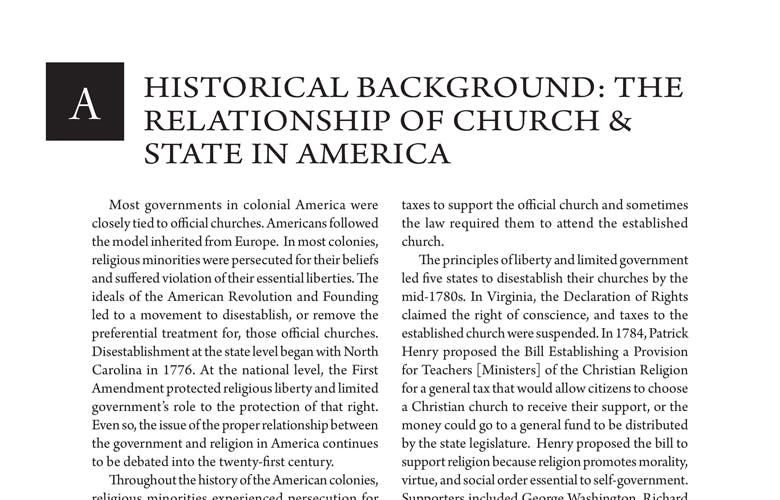Handout A: The Relationship of Church and State in America
Historical Background: The Relationship of Church & State in America
Most governments in colonial America were closely tied to official churches. Americans followed the model inherited from Europe. In most colonies, religious minorities were persecuted for their beliefs and suffered violation of their essential liberties. The ideals of the American Revolution and Founding led to a movement to disestablish, or remove the preferential treatment for, those official churches. Disestablishment at the state level began with North Carolina in 1776. At the national level, the First Amendment protected religious liberty and limited government’s role to the protection of that right. Even so, the issue of the proper relationship between the government and religion in America continues to be debated into the twenty-first century.
Throughout the history of the American colonies, religious minorities experienced persecution for their religious beliefs. Roger Williams and Anne Hutchinson were banished from Massachusetts for their unorthodox beliefs. A few Quakers in Massachusetts were executed for their religious beliefs. Maryland severely curtailed the civil liberties and religious practices of Roman Catholics after the Glorious Revolution of 1689. In Virginia, the government and established Anglican Church persecuted Baptists during and for decades after the Great Awakening. Baptist preachers could only preach with a license and were arrested, fined, and physically assaulted. They were whipped and ritually dunked in a “mock baptism” to the point of near drowning. Such actions in early 1774 shocked a young James Madison, who wrote to a friend:“ Persecution rages among some and to their eternal infamy . . . There are at this in the adjacent County not less than 5 or 6 well meaning men in close Goal[jail] for publishing their religious Sentiments . . .[I]pray for Liberty of Conscience to rev Remove Tab among us.” In colonial America, dissenters could usually attend their own religious services but often had to pay
The principles of liberty and limited government led five states to disestablish their churches by the mid-1780s. In Virginia, the Declaration of Rights claimed the right of conscience, and taxes to the established church were suspended. In 1784, Patrick Henry proposed the Bill Establishing a Provision for Teachers [Ministers] of the Christian Religion for a general tax that would allow citizens to choose a Christian church to receive their support, or the money could go to a general fund to be distributed by the state legislature. Henry proposed the bill to support religion because religion promotes morality, virtue, and social order essential to self-government. Supporters included George Washington, Richard Henry Lee, John Marshall, and several Christian denominations. James Madison responded with his “Memorial and Remonstrance,” arguing for religious liberty and disestablishment, and won passage of the Virginia Statute for Religious Freedom (1786).The law stated: “That no man shall be compelled to frequent or support any religious worship, place, or ministry whatsoever, nor shall be enforced, restrained, molested, or burthened in his body or goods, nor shall otherwise suffer on account of his religious opinions or belief . . . and that the same shall in no wise diminish, enlarge, or affect their civil capacities.”
At the Constitutional Convention in 1787, the delegates did not create an established church. Instead, in Article VI, Section 3, the Constitution banned religious tests for national office. Federal employees thus did not have to belong to a specific church or profess a certain religious belief. In 1791,the states ratified the Bill of Rights, which prohibited Congress from establishing a religion at the national level. The first part of the First Amendment, known as the Establishment Clause, read, “Congress shall make no law respecting an establishment of religion.” President George Washington thought religion was important for a self-governing people to be virtuous and moral. He thought his powers included proclaiming national days of thanksgiving as well as encouraging religious practice among several denominations and promising them government protection of their religious liberty and conscience.
The Constitution, moreover, specially banned Congress from establishing a religion and thus did not prevent states from legally having religious establishments. Connecticut did not dis establish its official church until 1818, and Massachusetts followed suit in 1833. The Bill of Rights was not applied to the states until after the Civil War.
President Thomas Jefferson took a different position than Washington regarding presidential authority to issue thanksgiving proclamations and refused to do so while president. In 1802, Jefferson wrote a letter to the Dan bury Baptists in which he stated that the First Amendment built “a wall of separation between church and state.” In the letter, Jefferson defended freedom of conscience (much as Washington had) because, “Religion is a matter which lies solely between Man & his God, that he owes account to none other for his faith or his worship, that the legitimate powers of government reach actions only, & not opinions.” In addition, Jefferson acknowledged that the First Amendment specifically stated that the national legislature could not establish a religion. The states were constitutionally allowed to have official churches, Jefferson recognized, but he hoped to see “the progress of those sentiments which tend to restore to men all his natural rights,” and the disestablishment of all established churches in the states.
The debate about the proper relationship of the government and religion at the local, state, and national levels would continue after the Civil War related to such issues as school prayer and the Pledge of Allegiance. Americans would also continue to debate the proper role of religion in the public square.
